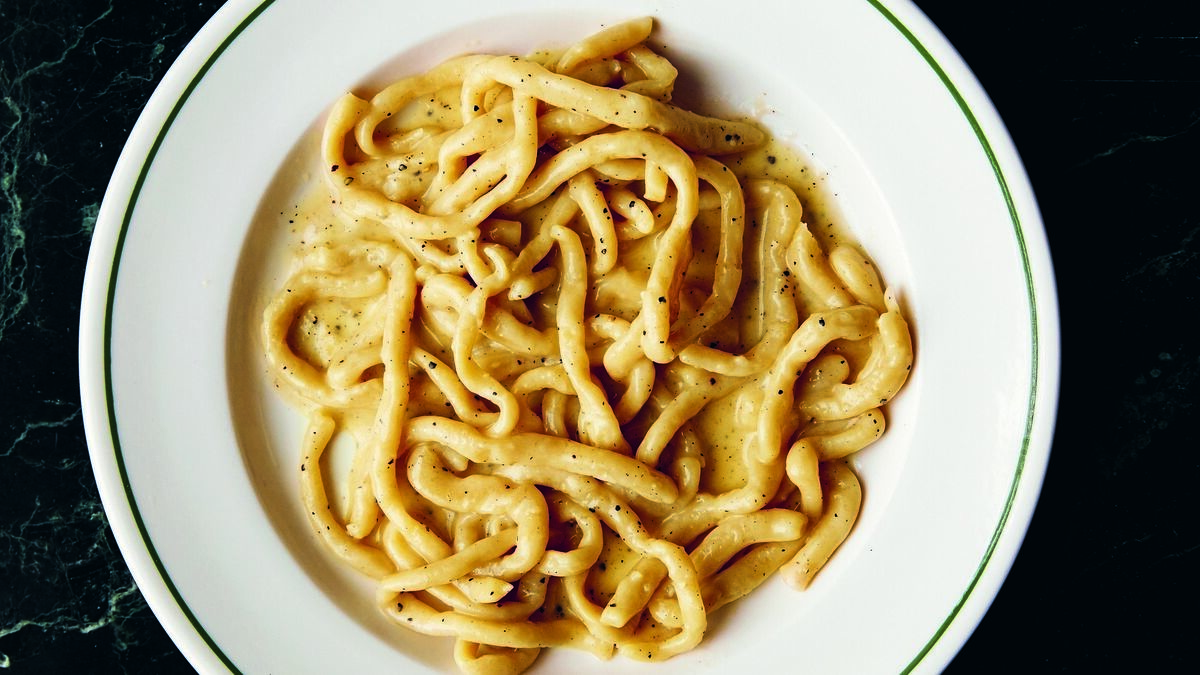Padella’s Pici Cacio e Pepe

Ingredients
500g fresh pici (see below)
About 1 heaped tsp freshly cracked black pepper
110g unsalted butter, cubed
a squeeze of lemon juice (about 10ml)
110g Parmesan, finely grated
Sea salt
For the pici dough
365g strong white bread flour, plus about 200g for storing the pici
155g tepid water
25ml extra virgin olive oil
5g salt

Method
For the pici, in a large cooking pot, bring 4-5 litres water to the boil and add a fistful of salt (only a fraction is absorbed into the pasta).
At the same time, in a pan large enough to easily hold all of the cooked ingredients, toast the freshly cracked pepper over a high heat for roughly 45-60 seconds or until you can smell the pepper, shaking the pan regularly to prevent it burning. Immediately add around 200ml of the seasoned pasta water (it will sizzle) and take the pan off the heat for 30 seconds.
Put the pan back over a medium-low heat, add the butter with the lemon juice to melt gently, then take off the heat. (It’s important to keep it off the heat while you cook the pasta, so that the pan isn’t scorching hot when you add the Parmesan.)
Loosen the pici bundles through your fingers so they won’t stick together as they cook. Drop the pici into the boiling water and cook for around 5 minutes.
Drain the pici as soon as it’s ready, keeping two mugs of pasta water.
Transfer the cooked pici to the buttery pepper sauce, put the pan back over a medium heat and stir until fully coated. Don’t worry if it looks quite soupy at this stage; the sauce will thicken more quickly than you think.
Add the grated Parmesan to the pici and stir vigorously to melt it into the sauce.
You should see a bit of steam rising out of the pan as you stir, so adjust your heat up if this isn’t happening. You might need to add small splashes of the reserved pasta water if the sauce needs loosening, stirring until you achieve a smooth, oozy sauce.
Once you’re happy with the consistency of the sauce, serve up the pasta on hot plates. Eat straight away.
To make the pici dough, put all the ingredients into a large bowl and mix until a dough is formed. (Alternatively, you can put all the ingredients into a food processor and whizz until a dough forms.)
Transfer the dough to a clean work surface and knead by pushing, stretching and rolling for few minutes until it’s smooth.
Wrap the dough ball in cling film and leave to rest somewhere cool for at least 30 minutes, or keep in the fridge for up to 2 days.
To roll the pici
1. On a clean work surface (ideally stainless steel, marble or unvarnished wood), cut off one-fifth of the dough and use a rolling pin to flatten it into a rectangle, about 3mm thick. (Keep the remaining dough ball covered with a damp tea-towel or wrapped in cling film.)
2, Using a knife, cut the flattened dough into 3-5mm strips.
3. Cut the strips of dough into roughly 10cm lengths.
4. Use the heels of your hands to roll each piece of dough into a thin pici strand, 20-30cm long and roughly 5mm diameter. (They should resemble grissini or thin breadsticks.)
5. Transfer the pici to a heavily floured tray or a large plate.
6. You can layer the pici on top of each other but make sure you heavily flour them as you layer, to prevent them sticking to each other.You can cook the pici straight away or store them in the fridge wrapped in cling film for 1-2 days.
ieFood
Newsletter
Feast on delicious recipes and eat your way across the island with the best reviews from our award-winning food writers.

